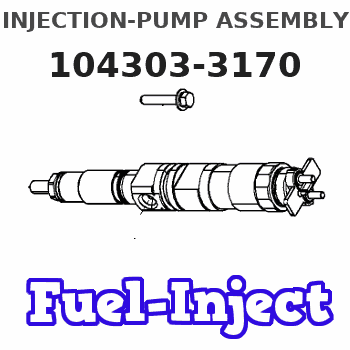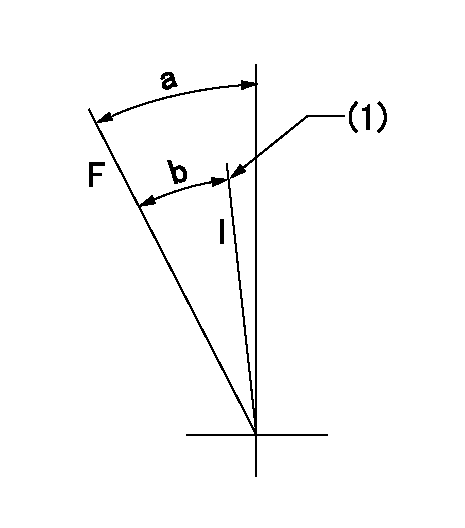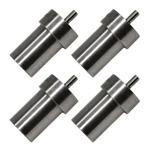Information injection-pump assembly
BOSCH
9 400 610 174
9400610174
ZEXEL
104303-3170
1043033170
ISHIKAWAJIMA-S
131016522
131016522

Rating:
Service parts 104303-3170 INJECTION-PUMP ASSEMBLY:
1.
_
3.
GOVERNOR
5.
AUTOM. ADVANCE MECHANIS
6.
COUPLING PLATE
7.
COUPLING PLATE
8.
_
9.
_
11.
Nozzle and Holder
13140 60 62
12.
Open Pre:MPa(Kqf/cm2)
11.8{120}
15.
NOZZLE SET
Include in #1:
104303-3170
as INJECTION-PUMP ASSEMBLY
Cross reference number
BOSCH
9 400 610 174
9400610174
ZEXEL
104303-3170
1043033170
ISHIKAWAJIMA-S
131016522
131016522
Zexel num
Bosch num
Firm num
Name
104303-3170
9 400 610 174
131016522 ISHIKAWAJIMA-S
INJECTION-PUMP ASSEMBLY
LEM853 * K
LEM853 * K
Calibration Data:
Adjustment conditions
Test oil
1404 Test oil ISO4113 or {SAEJ967d}
1404 Test oil ISO4113 or {SAEJ967d}
Test oil temperature
degC
40
40
45
Nozzle and nozzle holder
105780-8140
Bosch type code
EF8511/9A
Nozzle
105780-0000
Bosch type code
DN12SD12T
Nozzle holder
105780-2080
Bosch type code
EF8511/9
Opening pressure
MPa
17.2
Opening pressure
kgf/cm2
175
Injection pipe
Outer diameter - inner diameter - length (mm) mm 6-2-600
Outer diameter - inner diameter - length (mm) mm 6-2-600
Tester oil delivery pressure
kPa
157
157
157
Tester oil delivery pressure
kgf/cm2
1.6
1.6
1.6
Direction of rotation (viewed from drive side)
Right R
Right R
Injection timing adjustment
Direction of rotation (viewed from drive side)
Right R
Right R
Injection order
1-2-3
Pre-stroke
mm
1.95
1.9
2
Beginning of injection position
Drive side NO.1
Drive side NO.1
Difference between angles 1
Cyl.1-2 deg. 120 119.5 120.5
Cyl.1-2 deg. 120 119.5 120.5
Difference between angles 2
Cal 1-3 deg. 240 239.5 240.5
Cal 1-3 deg. 240 239.5 240.5
Injection quantity adjustment
Adjusting point
A
Rack position
7.8
Pump speed
r/min
1000
1000
1000
Each cylinder's injection qty
mm3/st.
33.5
32.5
34.5
Basic
*
Fixing the lever
*
Injection quantity adjustment_02
Adjusting point
B
Rack position
5.1+-0.5
Pump speed
r/min
350
350
350
Each cylinder's injection qty
mm3/st.
6
5
7
Fixing the lever
*
Test data Ex:
Governor adjustment

N:Pump speed
R:Rack position (mm)
(1)Rack difference between N = N1 and N = N2
----------
N1=(1220)r/min N2=1000r/min
----------
----------
N1=(1220)r/min N2=1000r/min
----------
Speed control lever angle

F:Full speed
I:Idle
(1)Stopper bolt setting
----------
----------
a=21deg+-3deg b=19deg+-6deg
----------
----------
a=21deg+-3deg b=19deg+-6deg
Stop lever angle

N:Pump normal
S:Stop the pump.
----------
----------
a=0deg+5deg b=(38deg)
----------
----------
a=0deg+5deg b=(38deg)
Information:
P-102: Engine Cranks But Will Not Start
Probable root causes:* Electrical power supply to the ECM.* Electrical connections to the fuel injectors.* Fuel supply* Engine Speed/Timing Signal* ECM or Personality Module failure.* Combustion problemPerform the following tests in order:1. P-210: Electrical Power Supply Test.2. If ECAP/DDT does not communicate with ECM, refer to P-120: ECAP/DDT Will Not Communicate With 3176 System, in this manual.3. Check that Fuel Injector Connector (J5/P5) is installed and oriented correctly.4. Check Fuel Pressure. Also, check that fuel system is primed and that fuel supply and return lines are not restricted. In temperatures below 0° C (32° F), check for congealed fuel (wax).5. P-221: Engine Speed/Timing Signal Test. Also be sure the timing reference ring is installed correctly (if the ring was installed backward during reassembly, the engine will not start).6. Check for combustion problems (too cold or mechanical problem).P-103: Engine Misfires, Runs Rough Or Is Unstable
If the problem is intermittent and cannot be re-created, refer to P-111: Intermittent Low Power Or Power Cutouts.If the problem is consistent and can be re-created, continue with this procedure. Probable root causes: If the problem only occurs under certain conditions (high rpm, full load, etc.) test the engine under those conditions. Troubleshooting the symptoms under other conditions can give misleading results.* Three cylinder cutout* Individual cylinder malfunction* Throttle position signal* Fuel supply - high pressure- low pressure- air in fuel- poor quality fuel* Air inlet restriction* Exhaust restrictionPerform the following tests in order:1. Verify that the complaint is not about the normal operation of the three-cylinder cutout feature.2. Isolate misfiring cylinder(s). Refer to P-222: Isolating Misfiring Cylinders, in this manual.3. Check throttle linkage adjustment. Refer to P-303: Throttle Position Sensor Adjustment, in this manual.4. Check Throttle Position Sensor. Refer to P-211: Throttle Position Sensor Test, in this manual.5. Check fuel quality. Refer to the Truck Performance Diagnostic Guide, Form No. SEBD0808.6. Inspect fuel system and check fuel pressure. Refer to 3176 Vehicular Diesel Engine, Form No. SENR4964, for Systems Operation, Testing & Adjusting.7. Check for air in fuel.8. Check for restrictions in the air inlet and exhaust systems. Refer to 3176 Vehicular Diesel Engine, Form No. SENR4964, for Systems Operation, Testing & Adjusting.P-104: Low Power/Poor Or No Response To Throttle
Probable root causes:* Active diagnostic codes* Customer Specified Parameters (normal operation)* Throttle position signal* Boost pressure signal* Fuel supply* Air inlet or exhaust restrictions* Inlet air system leaksPerform the following tests in order:1. Troubleshoot any ACTIVE diagnostic codes. * Codes 25 or 42 limit power or rpm or both* Code 32 limits engine speed to low idle* Code 56 may limit engine speed to low idle, depending on which parameter caused the code to be generated2. Verify that complaint is not normal (programmed parameter) operation.3. Verify that engine has shifted out of Cold Mode4. P-211: Throttle Position Sensor Test4. P-225: Boost Pressure Sensor Test5. Inspect fuel system components and check for correct fuel pressure.6. Check the air inlet and exhaust systems for restrictions.P-110: Intermittent Engine Shutdowns
Use this procedure ONLY
Probable root causes:* Electrical power supply to the ECM.* Electrical connections to the fuel injectors.* Fuel supply* Engine Speed/Timing Signal* ECM or Personality Module failure.* Combustion problemPerform the following tests in order:1. P-210: Electrical Power Supply Test.2. If ECAP/DDT does not communicate with ECM, refer to P-120: ECAP/DDT Will Not Communicate With 3176 System, in this manual.3. Check that Fuel Injector Connector (J5/P5) is installed and oriented correctly.4. Check Fuel Pressure. Also, check that fuel system is primed and that fuel supply and return lines are not restricted. In temperatures below 0° C (32° F), check for congealed fuel (wax).5. P-221: Engine Speed/Timing Signal Test. Also be sure the timing reference ring is installed correctly (if the ring was installed backward during reassembly, the engine will not start).6. Check for combustion problems (too cold or mechanical problem).P-103: Engine Misfires, Runs Rough Or Is Unstable
If the problem is intermittent and cannot be re-created, refer to P-111: Intermittent Low Power Or Power Cutouts.If the problem is consistent and can be re-created, continue with this procedure. Probable root causes: If the problem only occurs under certain conditions (high rpm, full load, etc.) test the engine under those conditions. Troubleshooting the symptoms under other conditions can give misleading results.* Three cylinder cutout* Individual cylinder malfunction* Throttle position signal* Fuel supply - high pressure- low pressure- air in fuel- poor quality fuel* Air inlet restriction* Exhaust restrictionPerform the following tests in order:1. Verify that the complaint is not about the normal operation of the three-cylinder cutout feature.2. Isolate misfiring cylinder(s). Refer to P-222: Isolating Misfiring Cylinders, in this manual.3. Check throttle linkage adjustment. Refer to P-303: Throttle Position Sensor Adjustment, in this manual.4. Check Throttle Position Sensor. Refer to P-211: Throttle Position Sensor Test, in this manual.5. Check fuel quality. Refer to the Truck Performance Diagnostic Guide, Form No. SEBD0808.6. Inspect fuel system and check fuel pressure. Refer to 3176 Vehicular Diesel Engine, Form No. SENR4964, for Systems Operation, Testing & Adjusting.7. Check for air in fuel.8. Check for restrictions in the air inlet and exhaust systems. Refer to 3176 Vehicular Diesel Engine, Form No. SENR4964, for Systems Operation, Testing & Adjusting.P-104: Low Power/Poor Or No Response To Throttle
Probable root causes:* Active diagnostic codes* Customer Specified Parameters (normal operation)* Throttle position signal* Boost pressure signal* Fuel supply* Air inlet or exhaust restrictions* Inlet air system leaksPerform the following tests in order:1. Troubleshoot any ACTIVE diagnostic codes. * Codes 25 or 42 limit power or rpm or both* Code 32 limits engine speed to low idle* Code 56 may limit engine speed to low idle, depending on which parameter caused the code to be generated2. Verify that complaint is not normal (programmed parameter) operation.3. Verify that engine has shifted out of Cold Mode4. P-211: Throttle Position Sensor Test4. P-225: Boost Pressure Sensor Test5. Inspect fuel system components and check for correct fuel pressure.6. Check the air inlet and exhaust systems for restrictions.P-110: Intermittent Engine Shutdowns
Use this procedure ONLY
Have questions with 104303-3170?
Group cross 104303-3170 ZEXEL
Toyo-Sha
Isuzu
Ishikawajima-S
104303-3170
9 400 610 174
131016522
INJECTION-PUMP ASSEMBLY
LEM853
LEM853
